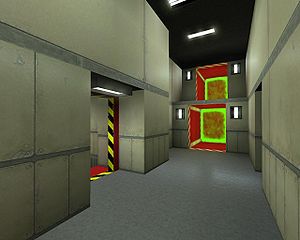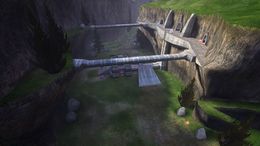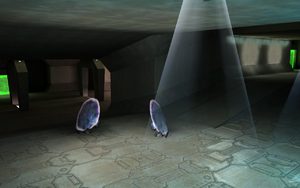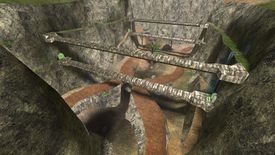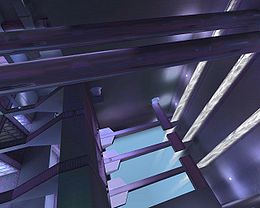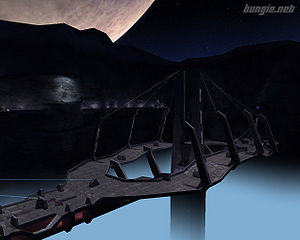With the recent release of Halo: Combat Evolved Anniversary on the PC version of Halo: The Master Chief Collection, many of the old Halo: CE multiplayer maps are being brought back into the spotlight as players dive in to enjoy the ‘new’ multiplayer maps on the PC release of MCC and, for older Halo players, indulge in some classic Xbox nostalgia.
However, just as we are presented with the joy of experiencing maps like Hang ‘Em High, Blood Gulch and Longest online on the PC once again, we are also faced with the inevitable groans when we are dealt a Halo CE map that is less well-remembered. After all, not only did the original release of Halo CE have a fair share of less popular classic maps, there were also some maps added to the original PC port of Halo CE by Gearbox that were slated by fans.
Although many of these maps are tried and tested, and have been played to death by Halo fans for years, perhaps there is still something to be said in defence of the maps that many in the community seem to dislike. After all, each and every Halo CE map is unique in its own right, and some of these maps represent the earliest examples of Bungie experimenting with Halo map design. Clearly they went with what worked, and this has led to some of the best enduring classic maps in the series – but they also tried some crazy multiplayer map ideas, and these are some of the maps we will be covering today.
Chiron TL-34
Arguably the most unique non-Forge map in Halo history, Chiron TL-34 seems to have a very bad reputation among the Halo fan community for its tight spaces, confusing layout and claustrophobic repetition. However, lovers and haters of this map alike must agree that is has a very interesting design. Its asymmetry, coupled with the fact that every single room is unique, makes for a fascinating map design.
There are certain gamemodes in the Master Chief Colllection in which this map shines, one in particular being Team Muskets, a gamemode in which every player has a shotgun and no shields. This makes for a hectic gamemode that relies a lot on players memorising the map over time, and knowing which rooms are best for defending and which rooms are common spots for ambushes.
The creepy ambient noises combined with the tight, confined spaces make Chiron TL-34 an intense map. Interestingly, when playing on team games, you can see your teammates markers wherever they are on the map, revealing that the rooms are actually significantly further away from each other than one might assume. This, coupled with the bizarre sounds you can hear from time to time, begs the question of what is located between the rooms…
Boarding Action
Boarding Action, like Chiron TL-34, is a map that has a truly unique design – two structures oppose each other, with a vast gulf of space between them. The only way to travel from one structure to the other is via teleporter, so players are presented with a choice – either make a dash for the teleporters and attempt to attack the enemy head-on, or use a Sniper Rifle or Magnum to attack the enemy from across the chasm.
Although there are clearly issues with this map, including the lack of cover from the overpowered Magnum, the abundance of ranged weapons, and the fact that there are some really easy ways to score within seconds of getting the flag in Capture the Flag using the teleporters, which isn’t a good thing in a Capture the Flag game.
However, there are still some good things about this map – it makes for some great sniper duels, the Rocket Launcher and Fuel Rod Gun are fun to use, and generally the concept of two ships firing at each other is a novel one – and like all Halo CE maps, the ambient sounds are creepy as ever. The last thing your Spartan hears as he tumbles into the empty abyss of space is the distant roar of the solar winds as they buffet the two opposing spaceships…
Danger Canyon
This map has a very interesting symmetrical design, incorporating a vast open horseshoe-shaped canyon spanned by Forerunner bridges. A dense network of tunnels linked to an underground chamber inhabited by Covenant technology gives this map a very authentic feel, as it certainly looks and feels like a Halo map. The environment is even reminiscent of the interior of the Silent Cartographer island.
Like a lot of maps designed for the PC port by Gearbox, this map has Big Team Battle in mind and is therefore very big, and thus not suited for smaller game modes. This map is a blast on Big Team Battle, with vehicles and co-ordinated use of the warren of tunnels making for some diverse methods of attack.
In terms of aesthetics, Danger Canyon is a beautiful map – it embodies all of the iconic design elements that made the second level of Halo: Combat Evolved so memorable, including the combination of natural terrain and angular metallic Forerunner structures. This map actually takes some getting used to, as the layout is designed to confuse the uninitiated – something very Forerunner.
Rat Race
A gloomy, atmospheric map set in subterranean tunnels, Rat Race is one of those maps that you don’t often hear people complain about, but you don’t really hear people praise either. However, what appears on the surface to be a relatively dull indoor map is actually a lot more complex then it initially appears, thanks to a combination of its asymmetrical design and the use of teleporters. Probably the major draw factor with this map for a lot of people is the setting – it is hardly the most visually appealing of Halo CE’s maps, and resembles the kind level aesthetics that you would find in very early shooters.
Rat Race is one of the few Halo maps set completely underground, with absolutely no windows or means of seeing the skybox. his gives Rat Race a unique feel that is difficult to place, in that the claustrophobic corridors enhance the tension of combat, particularly as the leftover Human and Covenant equipment gives players the feelinggn that they are not alone here.
In terms of gameplay, Rat Race is actually more dynamic that it first appears. It if the enemy team has the teleporter locked down, you can sneak around them using the Forerunner facility, and if their attention is on keeping the main rooms, you can use the dirt cave to get the drop on them with a convenient hatch for sneak attacks. Overall, although Halo: CE’s interior maps are often designed in a symmetrical fashion, Rat Race offers an assymetrical alternative that should not be underestimated.
Infinity
This map is interesting, as it suffers from major design flaws that decrease its viability for almost every gametype except one – Race. Infinity is one of those maps that is just too big – walking from one side of the map to the other takes far too long, and even with the Ghosts lying around traversing this map on foot feels like a chore. Having said that, for vehicular combat this map is surprisingly fun – you often end up in desperate chase scenarios in which one heavily armed Warthog chases down a Ghost only to be intercepted by an enemy Warthog, at which point all hell breaks loose.
Another aspect of Infinity that seems questionable its is layout – the map consists of incredibly long thin canyons that come together to form a wonky ouroboros or ‘infinity sign’ (hence the map’s name). This is an interesting layout for Capture-the-Flag, but the gametype that really shines here is Race – not only does the map seem to have been designed with that gametype in mind with multiple goals to every destination, but the variety of vehicles and abundance of long straights make the Race gamemode this map’s unusual forte.
Damnation
Although not necessarily underrated, Damnation is rarely a map that you see pop up in people’s Top Ten Halo Maps lists. But all things considered, Damnation is a fine map. In fact, many consider it superior to open maps like Hang Em’ High, as Damnation features more interior areas that balance out the open spaces – this is a good counter to Halo: CE’s god-pistol, as this sidearm allows even a single player to dominate open terrain with the notorious three-shot kill, making open maps with lots of interior corridors like Damnation a welcome balance.
By far the most memorable feature of Damnation for many is the Covenant architecture, as Damnation depicts a previously-unseen Covenant Hydro-Processing Facility that uses the three waterfalls that dominate the map to generate power. The alien humming of the machinery as well as the constant roar of the waterfalls gives this map a unique aesthetic that is only enhanced by the excellent ambient sounds.
Gephyrophobia
This bizarre map is certainly unique in its design – a massive Forerunner bridge spans a snowy canyon at night, the bridge itself is similar to the one seen on Assault on the Control Room only it appears to be much wider and it is flanked by facilities on either side of the valley. The canyon itself has no bottom, and a deep fog shrouds the origin point of the bridge’s main column support. This map feels particularly unsafe.
Unfortunately, this excellent setting is somewhat squandered by this map’s poor choice of identity – the fact that it is designed to be a large map for Big Team battle games of 16 players means that vehicles such as Warthogs are present, and for some reason they are placed on the bridge itself. This makes for some awkward gameplay, particularly since the playspace for the Warthogs is so restricted.
This map would have been greatly improved if the Warthogs were swapped out for additional Banshees, turning the map into a starfighter combat simulator. Players on the bridge or on the platforms either side of the bridge could man turrets or use heavy weapons whilst the majority of the players battle it out in the skies.
We hope you enjoyed this list of the Top 7 Most Underrated Halo Maps. Many thanks to Halopedia as they were the source for the images in this post.
